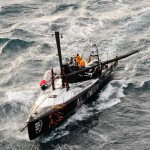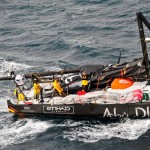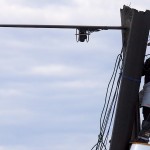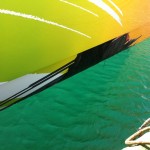LIFE IS THE FRIENDS WE LEAVE BEHIND.
Category: Volvo Ocean Race
PIRACY PLANS
The Volvo Ocean Race has revealed its anti-piracy plan, which will see the fleet transported by armed heavy lift ship from an undisclosed Safe Haven Port in the Indian Ocean and resume racing from a set-down point along the Sharjah coastline in the northern Emirates, within a day’s sailing of the Leg 2 finish in Abu Dhabi.
“This solution means we still have the exciting race finish into Abu Dhabi as always planned, while steering clear of the most dangerous waters off the Eastern African corridor” – Knut Frostad
Race organisers announced in August that the route for Legs 2 and 3 would be re-drawn because of the increased threat of piracy in the Indian Ocean. With the fleet set to depart Cape Town for the start of Leg 2 on Sunday, Race Director Jack Lloyd has made parts of the plan public for the first time.
The six boats will leave Cape Town as scheduled on Sunday, December 11 and continue to be tracked as normal until they reach a point in the Indian Ocean. From there, details about the boats’ location will be switched off to the public as they sail on to a Safe Haven Port. At that port, the boats will be loaded on to a ship protected by armed guards and featuring other security measures and transported to the northern Emirates.
Once unloaded, Race Management will decide where exactly to re-start the race for a short competitive sprint into Abu Dhabi, which is hosting the event from December 31 to January 14. The sailors will not be on board the ship.
The scoring system has been modified, so that 80 per cent of the points of Leg 2 are based on the race between Cape Town and Safe Haven 1 and 20 percent for the short sprint into Abu Dhabi. For Leg 3, the operation will be reversed, with a short sprint from Abu Dhabi at the start of the leg. The boats will go back on a ship and be transported again to a Safe Haven Port. From there, they will sail on as normal to the Leg 3 finish in Sanya, China.
Race Director Jack Lloyd said: “It is unfortunate that we have to take these measures but we have followed professional advice every step of the way. It is still very much a race around the world and we believe we have found a fair points system that will help make it an exciting sprint into Abu Dhabi.
“The teams all understand the situation and have given us their full support.”
Lloyd and Knut Frostad, the CEO of the race, have worked closely with Dryad Maritime Intelligence plus government agencies including European Union Naval Force Somalia (EUNAVFOR), UK Maritime Trade Operations (UKMTO) and the Maritime Security Centre, Horn of Africa (MSCHOA) as well as the sport’s governing body, the International Sailing Federation (ISAF).
Frostad said safety had always been the highest priority in getting the teams through the areas worst affected by piracy.
“Piracy is a threat to the entire race and the measures we are taking are designed to keep the sailors, the shore crew and the boats as safe as possible, while preserving the competitive nature of the race,” Frostad said.
“This solution means we still have the exciting race finish into Abu Dhabi as always planned, while steering clear of the most dangerous waters off the Eastern African corridor.”
Piracy is a well-organised and highly lucrative business and it has expanded into a vast area off the coast of Somalia. According to figures from Dryad Maritime Intelligence,1,181 seafarers were kidnapped by pirates in 2010.
Dryad’s Graeme Gibbon Brooks said pirate operations in the eastern part of the Indian Ocean had been significantly restricted.
“This factor as well as very careful planning has reduced the probability of an encounter to as low as reasonably possible,” he said. “But while the probability is small, the impact of an attack when it happens is extremely high.”
Like Abu Dhabi, Sanya is hosting the race for the first time. The Chinese tourist city in Hainan Province will open its Race Village from February 4-19.
ABOARD MAR MONSTRO
isn’t technology remarkable
AND THEN THERE WERE FOUR
Not even 24 hours and two boats of the six in the volvo race have returned to Alicante, Spain. Ian Walker, skipper of Azzam and Mike Sanderson, skipper of Sanya are both returned to Alicante. One with a broken mast and the other with delamination. So much for trying to break your boat before the race starts.
NO MORE LEEWAY
New navigation capability to PUMA Ocean Racing Team
Nortek announced today that it has collaborated with the PUMA Ocean Racing team to develop a modified compact Doppler Velocity Log (DVL) for PUMA’s Mar Mostro Volvo Open 70 yacht competing in the Volvo Ocean Race 2011-2012. The project, which was completed over the course of the past year, has resulted in the successful integration of boat speed, leeway and in-situ ocean current readings. Translation: a secret weapon in the battle to go as fast and efficiently as possible.
The message below is the full press release from Nortek and the PUMA Ocean Racing Team — for questions or comments, please chime in on theNortek Facebook page.
“The collaboration between Nortek and the entire PUMA team has resulted in an tool that provides unique information to the sailing crew. They can now measure leeway, a first in sailing, and use it to measure ocean currents much more precisely than ever before,” said Atle Lohrmann, CTO of Nortek.
Nortek started developing this capability during the 2008 Star class Olympic trials with the Norwegian team skippered by Eivind Melleby, also a veteran of the Volvo Ocean Race. Nortek went on to work with the TP52 ocean racing team Caixa Galicia with a predecessor to the existing sensor with Caixa navigator Robert Hopkins.
“This is the biggest advancement in sailing instrumentation since the invention of the GPS,” said Hopkins, who runs performance testing for PUMA and worked with Nortek on the project. “Nortek adapted their new DVL technology to our sailing performance needs, to measure very high speeds along the boat’s track and very low speeds across it. With Nortek’s history of deploying instruments on buoys in hostile Arctic conditions, we knew that we could trust the Nortek DVL in a race around the world.”
Leeway is the sideways skidding angle a boat makes as it sails forward. Leeway can be changed on a Volvo Open 70 yacht by adjusting the daggerboard immersion and canting the keel. The adjustable daggeboards and keel act like wings underwater to counteract the force of the sails. The crew relies on Nortek DVL leeway measurements to optimize PUMA’sMar Mostro performance at all times, providing the core data upon which every other performance measurement is based.“I can’t tell you how important it is to finally know how fast the boat is going in all conditions. We really feel this is the first time boat speed has been accurately measured without using various types of cumbersome and complex tables within the boat’s instrumentation. It’s a huge factor for something as simple as a sail change or as complex as routing,” said Ken Read, skipper of the PUMA Ocean Racing team. “Nortek and our entire team, especially the shore crew, worked diligently to make this project a reality. The technology already helped us to win the Transatlantic Race in July, and it will be a key component as we race around the world.”
The Nortek DVL uses acoustic techniques to measure water velocity along each of the four beams. The sensor is mounted in the bottom of the lead bulb of the keel. The acoustic beams are oriented forward, aft and abeam. Data from each beam is streamed to the on board computer which also receives data from the inertial motion sensor and the keel cant angle sensor. Velocity and orientation measurements are then used to output true forward boat speed and leeway. Real time currents can be directly estimated by differencing the GPS boat speed over ground and the boat speed through the water.
Similar systems were developed for the seismic survey fleet and Nortek recently delivered the first operational navigation system to Fugro-Geoteam in Oslo to be mounted on two Barovane seismic diverters. The diverters keep the towed acoustic streamers separated and like the Puma-DVL, the system measures the angle of attack, the through water speed and ocean currents near the surface. The difference was the space available for the acoustic transponder. “We worked very hard to miniaturize the DVL unit that was installed aboard PUMA’s Mar Mostro,” stated Lohrmann.
The project is an important milestone for Nortek because it demonstrates how well the acoustic Doppler technology performs in very challenging conditions and that the system can be fully integrated into modern navigation systems. The fact that the PUMA Ocean Racing technology team was able to integrate the DVL with other sensors on the boat is a testament to the quality and sophistication of modern yacht racing.
The PUMA Ocean Racing team sets out on the first leg of the Volvo Ocean Race 2011-2012 on Saturday, November 5, departing Alicante, Spain, for Cape Town, South Africa. The 11-member crew will travel 39,000 nautical miles over nine months, sailing from Alicante to Cape Town, and on to Abu Dhabi, UAE; Sanya, China; Auckland, New Zealand; around Cape Horn to Itajaí, Brazil; to Miami, Florida, USA; Lisbon, Portugal; Lorient, France, finishing in Galway, Ireland in July 2012.
For details about the PUMA-DVL, including images, please visit our websitehttp://www.nortek-as.com/puma-ocean-racing
16 HOURS TO THE START OF THE VOLVO OCEAN RACE
Abu Dhabi, skippered by Ian Walker, won the opening inshore race of the Volvo Ocean Race. Mar Monstro (Puma) skippered by Ken Read was second.
It is points on the board for each, but this is a distance race; and whoever has the best weather routing win win.
NEW CAT IN TOWN
This Friday, “Mar Mostro” Puma racing’s newest ride will be launched; sailing by Monday. No photos as the team wants to have the pleasure of revealing the graphics.
THE CAT IS BACK
“Il Monstro” arrived back in Newport yesterday evening, with Ken’s brother Brad having completed his first transatlantic race; on a boat we would all love to have sailed. Docked at Charlie Dana’s Newport Shipyard, next to “Leopard of London” and “Speedboat”. A sort of trinity of sailboat racing, formula ones of the water.
“Il Monstro” will set up training here in Newport in preparation for the next Volvo Ocean Race.
The bottom photo is a panorama of Shields racing last night on Narragansett Bay, comprised of 10 photos stitched together. Spring is coming to the Northeast.
VIRGIN MONEY aka SPEEDBOAT
 Speedboat left today from New York in an attempt to break the monohull powered winch trans-atlantic record. Aboard is an all star crew headed by Mike Sanderson.
Speedboat left today from New York in an attempt to break the monohull powered winch trans-atlantic record. Aboard is an all star crew headed by Mike Sanderson.







.jpg)
